Pioneer XV-DV740, S-DV440, S-DV740, XV-DV440 User Manual

DVD/CD Receiver
XV-DV440 XV-DV740
Speaker System
S-DV440 S-DV740
Operating Instructions
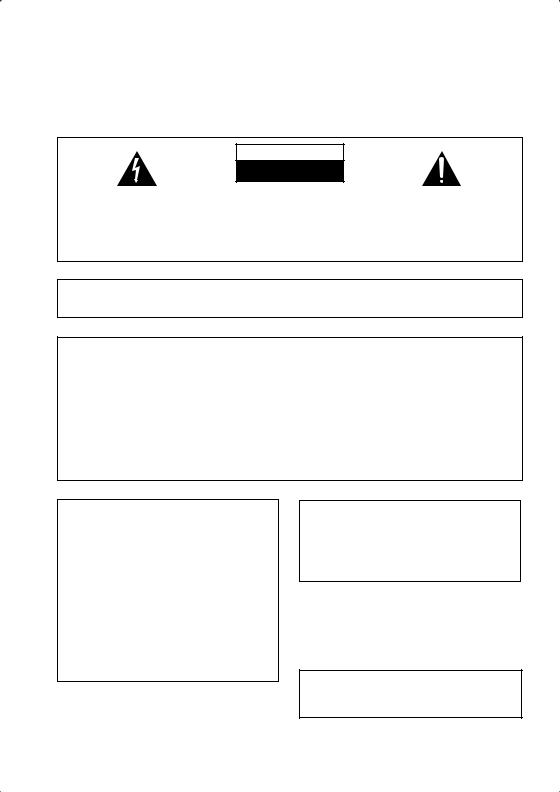
CAUTION
The lightning flash with arrowhead, within an equilateral triangle, is intended to alert the user to the presence of uninsulated "dangerous voltage" within the product's enclosure that may be of sufficient magnitude to constitute a risk of electric shock to persons.
RISK OF ELECTRIC SHOCK
DO NOT OPEN
CAUTION:
TO PREVENT THE RISK OF ELECTRIC SHOCK, DO NOT REMOVE COVER (OR BACK). NO USER-SERVICEABLE PARTS INSIDE. REFER SERVICING TO QUALIFIED SERVICE PERSONNEL.
The exclamation point within an equilateral triangle is intended to alert the user to the presence of important operating and maintenance (servicing) instructions in the literature accompanying the appliance.
D1-4-2-3_En
IMPORTANT NOTICE – THE SERIAL NUMBER FOR THIS EQUIPMENT IS LOCATED IN THE BOTTOM.
PLEASE WRITE THIS SERIAL NUMBER ON YOUR ENCLOSED WARRANTY CARD AND KEEP IN A SECURE AREA. THIS IS FOR YOUR SECURITY.
NOTE: This equipment has been tested and found to comply with the limits for a Class B digital device, pursuant to Part 15 of the FCC Rules. These limits are designed to provide reasonable protection against harmful interference in a residential installation. This equipment generates, uses, and can radiate radio frequency energy and, if not installed and used in accordance with the instructions, may cause harmful interference to radio communications. However, there is no guarantee that interference will not occur in a particular installation. If this equipment does cause harmful interference to radio or television reception, which can be determined by turning the equipment off and on, the user is encouraged to try to correct the interference by one or more of the following measures:
–Reorient or relocate the receiving antenna.
–Increase the separation between the equipment and receiver.
–Connect the equipment into an outlet on a circuit different from that to which the receiver is connected.
– Consult the dealer or an experienced radio/TV technician for help. |
D8-10-1-2_En |
CAUTION – PREVENT ELECTRIC SHOCK DO NOT USE THIS (POLARIZED) PLUG WITH AN EXTENSION CORD. RECEPTACLE OR OTHER OUTLET UNLESS THE BLADES CAN BE FULLY INSERTED TO PREVENT BLADE EXPOSURE.
ATTENTION – POUR PREVENIR LES CHOCS ELECTRIQUES NE PAS UTILISER CETTE FICHE POLARISEE AVEC UN PROLONGATEUR UNE PRISE DE COURANT OU UNE AUTRE SORTIE DE COURANT, SAUF SI LES LAMES PEUVENT ETRE INSEREES A FOND SANS EN LAISSER AUCUNE PARTIE A DECOUVVERT.
WARNING: Handling the cord on this product or cords associated with accessories sold with the product will expose you to lead, a chemical known to the State of California and other governmental entities to cause cancer and birth defects or other reproductive harm.
Wash hands after handling |
D36-P4_En |
WARNING – TO PREVENT FIRE OR SHOCK HAZARD, DO NOT EXPOSE THIS APPLIANCE TO RAIN OR MOISTURE.
D1-4-2-1_En
NOTE: THE NO USER-SERVICEABLE PARTS COMPARTMENT WARNING IS LOCATED ON THE APPLIANCE BOTTOM.
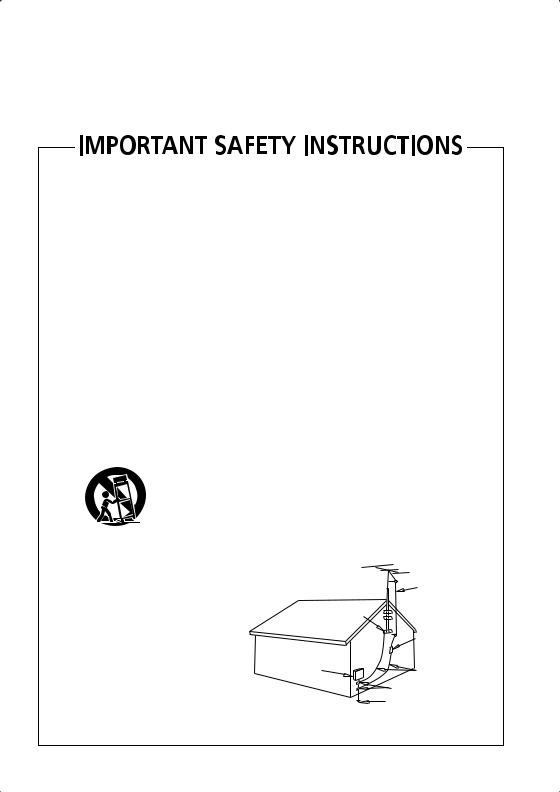
READ INSTRUCTIONS — All the safety and operating instructions should be read before the product is operated.
RETAIN INSTRUCTIONS — The safety and operating instructions should be retained for future reference.
HEED WARNINGS — All warnings on the product and in the operating instructions should be adhered to.
FOLLOW INSTRUCTIONS — All operating and use instructions should be followed.
CLEANING — The product should be cleaned only with a polishing cloth or a soft dry cloth. Never clean with furniture wax, benzine, insecticides or other volatile liquids since they may corrode the cabinet.
ATTACHMENTS — Do not use attachments not recommended by the product manufacturer as they may cause hazards.
WATER AND MOISTURE — Do not use this product near water — for example, near a bathtub, wash bowl, kitchen sink, or laundry tub; in a wet basement; or near a swimming pool; and the like.
ACCESSORIES — Do not place this product on an unstable cart, stand, tripod, bracket, or table. The product may fall, causing serious injury to a child or adult, and serious damage to the product. Use only with a cart, stand, tripod, bracket, or table recommended by the manufacturer, or sold with the product. Any mounting of the product should follow the manufacturer’s instructions, and should use a mounting accessory recommended by the manufacturer.
CART — A product and cart combination should be moved with care. Quick stops, excessive force, and uneven surfaces may cause the product and cart combination to overturn.
VENTILATION — Slots and openings in the cabinet are provided for ventilation and to ensure reliable operation of the product and to protect it from overheating, and these openings must not be blocked or covered. The openings should never be blocked by placing the product on a bed, sofa, rug, or other similar surface. This product should not be placed in a built-in installation such as a bookcase or rack unless proper ventilation is provided or the manufacturer’s instructions have been adhered to.
POWER SOURCES — This product should be operated only from the type of power source indicated on the marking label. If you are not sure of the type of power supply to your home, consult your product dealer or local power company.
LOCATION – The appliance should be installed in a stable location.
NONUSE PERIODS – The power cord of the appliance should be unplugged from the outlet when left un-used for a long period of time.
GROUNDING OR POLARIZATION |
OBJECT AND LIQUID ENTRY — Never push |
• If this product is equipped with a polarized |
objects of any kind into this product through |
alternating current line plug (a plug having one |
openings as they may touch dangerous voltage |
blade wider than the other), it will fit into the |
points or short-out parts that could result in a |
outlet only one way. This is a safety feature. If |
fire or electric shock. Never spill liquid of any |
you are unable to insert the plug fully into the |
kind on the product. |
outlet, try reversing the plug. If the plug should |
SERVICING — Do not attempt to service this |
still fail to fit, contact your electrician to replace |
product yourself as opening or removing covers |
your obsolete outlet. Do not defeat the safety |
may expose you to dangerous voltage or other |
purpose of the polarized plug. |
hazards. Refer all servicing to qualified service |
• If this product is equipped with a three-wire |
personnel. |
grounding type plug, a plug having a third |
DAMAGE REQUIRING SERVICE — Unplug this |
(grounding) pin, it will only fit into a grounding |
product from the wall outlet and refer servicing |
type power outlet. This is a safety feature. If you |
to qualified service personnel under the |
are unable to insert the plug into the outlet, |
following conditions: |
contact your electrician to replace your obsolete |
• When the power-supply cord or plug is |
outlet. Do not defeat the safety purpose of the |
damaged. |
grounding type plug. |
• If liquid has been spilled, or objects have fallen |
POWER-CORD PROTECTION — Power-supply |
into the product. |
cords should be routed so that they are not likely |
• If the product has been exposed to rain or water. |
to be walked on or pinched by items placed |
• If the product does not operate normally by |
upon or against them, paying particular |
following the operating instructions. Adjust only |
attention to cords at plugs, convenience |
those controls that are covered by the operating |
receptacles, and the point where they exit from |
instructions as an improper adjustment of other |
the product. |
controls may result in damage and will often |
OUTDOOR ANTENNA GROUNDING — If an |
require extensive work by a qualified technician |
outside antenna or cable system is connected to |
to restore the product to its normal operation. |
the product, be sure the antenna or cable |
• If the product has been dropped or damaged in |
system is grounded so as to provide some |
any way. |
protection against voltage surges and built-up |
• When the product exhibits a distinct change in |
static charges. Article 810 of the National |
performance — this indicates a need for service. |
Electrical Code, ANSI/NFPA 70, provides |
REPLACEMENT PARTS — When replacement parts |
information with regard to proper grounding of |
are required, be sure the service technician has |
the mast and supporting structure, grounding of |
used replacement parts specified by the |
the lead-in wire to an antenna discharge unit, |
manufacturer or have the same characteristics |
size of grounding conductors, location of |
as the original part. Unauthorized substitutions |
antenna-discharge unit, connection to |
may result in fire, electric shock, or other |
grounding electrodes, and requirements for the |
hazards. |
grounding electrode. See Figure A. |
SAFETY CHECK — Upon completion of any service |
LIGHTNING — For added protection for this |
or repairs to this product, ask the service |
product during a lightning storm, or when it is |
technician to perform safety checks to |
left unattended and unused for long periods of |
determine that the product is in proper |
time, unplug it from the wall outlet and |
operating condition. |
disconnect the antenna or cable system. This |
WALL OR CEILING MOUNTING — The product |
will prevent damage to the product due to |
should not be mounted to a wall or ceiling. |
lightning and power-line surges. |
HEAT — The product should be situated away from |
POWER LINES — An outside antenna system |
heat sources such as radiators, heat registers, |
should not be located in the vicinity of overhead |
stoves, or other products (including amplifiers) |
power lines or other electric light or power |
that produce heat. |
circuits, or where it can fall into such power |
|
lines or circuits. When installing an outside |
|
antenna system, extreme care should be taken |
|
to keep from touching such power lines or |
|
circuits as contact with them might be fatal. |
|
OVERLOADING — Do not overload wall outlets, |
|
extension cords, or integral convenience |
|
receptacles as this can result in a risk of fire or |
ANTENNA |
electric shock. |
|
|
LEAD IN |
|
WIRE |
|
GROUND |
|
CLAMP |
|
ANTENNA |
|
DISCHARGE UNIT |
|
(NEC SECTION 810-20) |
ELECTRIC |
|
SERVICE |
GROUNDING CONDUCTORS |
EQUIPMENT |
(NEC SECTION 810-21) |
|
GROUND CLAMPS |
Fig. A |
POWER SERVICE GROUNDING |
ELECTRODE SYSTEM |
|
|
(NEC ART 250, PART H) |
|
NEC — NATIONAL ELECTRICAL CODE |
|
D1-4-2-2_En |
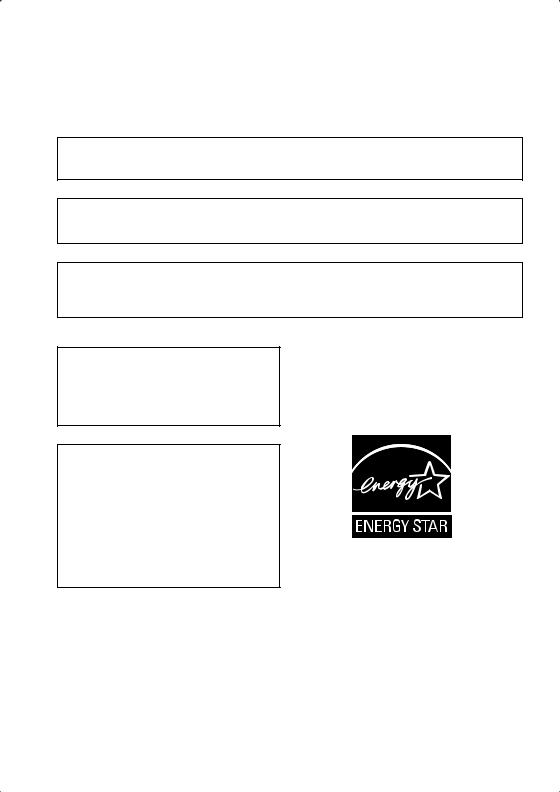
This Class B digital apparatus complies with Canadian ICES-003.
Cet appareil numérique de la Classe B est conforme à la norme NMB-003 du Canada.
D8-10-1-3_EF
Information to User
Alteration or modifications carried out without appropriate authorization may invalidate the user’s right to operate
the equipment. |
D8-10-2_En |
CAUTION : USE OF CONTROLS OR ADJUSTMENTS OR PERFORMANCE OF PROCEDURES OTHER THAN THOSE SPECIFIED HEREIN MAY RESULT IN HAZARDOUS RADIATION EXPOSURE.
CAUTION : THE USE OF OPTICAL INSTRUMENTS WITH THIS PRODUCT WILL INCREASE EYE HAZARD. D6-8-2-1_En
This product is for general household purposes. Any failure due to use for other than household purposes (such as long-term use for business purposes in a restaurant or use in a car or ship) and which requires repair will be charged for even during the warranty period.
This product incorporates copyright protection technology that is protected by method claims of certain U.S. patents and other intellectual property rights owned by Macrovision Corporation and other rights owners. Use of this copyright protection technology must be authorized by Macrovision Corporation, and is intended for home and other limited viewing uses only unless otherwise authorized by Macrovision Corporation. Reverse engineering or disassembly is prohibited.
Energy-saving design
This system is designed to use 0.5W of electricity when power is switched to standby.
For U.S. and Australia Model
C67-7-3_En

Thank you for buying this Pioneer product.
Please read through these operating instructions so that you will know how to operate your model properly. After you have finished reading the instructions, put them in a safe place for future reference.
Contents
01 Before you start
Features . . . . . . . . . . . . . . . . . . . . . . . . . . . 7
Disc / content format playback
compatibility . . . . . . . . . . . . . . . . . . . . . . . 7
CD-R/RW compatibility . . . . . . . . . . . . . . 8 DVD-R/RW compatibility . . . . . . . . . . . . . 8 PC-created disc compatibility . . . . . . . . . 8 Compressed audio compatibility . . . . . . . 8
About WMA . . . . . . . . . . . . . . . . . . . . . . . 8
JPEG file compatibility . . . . . . . . . . . . . . . 8
02 Controls and displays
Front panel. . . . . . . . . . . . . . . . . . . . . . . . . 9 Display . . . . . . . . . . . . . . . . . . . . . . . . . . . 10 Remote control . . . . . . . . . . . . . . . . . . . . 11
Auto listening mode . . . . . . . . . . . . . . . . .24
Listening in surround sound . . . . . . . . . . .25 Dolby Pro Logic II Music settings . . . . . .25 Using the Advanced Surround effects . . . .26 Using Front Surround . . . . . . . . . . . . . . . .26
Adjusting the Advanced and
Front Surround effect level . . . . . . . . . . .27
Listening in stereo . . . . . . . . . . . . . . . . . . .27
Listening with headphones . . . . . . . . . . . .27
Enhancing dialogue. . . . . . . . . . . . . . . . . .28
Listening with a virtual surround back speaker . . . . . . . . . . . . . . . . . . . . . . . . . . .28
Using Quiet and Midnight listening
modes . . . . . . . . . . . . . . . . . . . . . . . . . . . .28
Adjusting the bass and treble . . . . . . . . . .29 Boosting the bass level . . . . . . . . . . . . . . .29
03 Getting started
Switching on and setting up. . . . . . . . . . . 14
Setting the clock . . . . . . . . . . . . . . . . . . 15
Home theater sound setup. . . . . . . . . . . . 16 Using the Room Setup . . . . . . . . . . . . . . . 16 Setting up the remote to control your
TV. . . . . . . . . . . . . . . . . . . . . . . . . . . . . . . 17
Using the on-screen displays . . . . . . . . . . 17
Playing discs . . . . . . . . . . . . . . . . . . . . . . 18
Basic playback controls . . . . . . . . . . . . . 18 Resume and Last Memory . . . . . . . . . . . 19 DVD-Video disc menus . . . . . . . . . . . . . 20 Video CD/Super VCD PBC menus . . . . . 21 Listening to the radio . . . . . . . . . . . . . . . . 21 Improving poor FM reception. . . . . . . . . 22 Memorizing stations . . . . . . . . . . . . . . . 22 Listening to station presets . . . . . . . . . . 23 Listening to other sources . . . . . . . . . . . . 23
04 Listening to your system
About the listening modes . . . . . . . . . . . . 24
05 Playing discs
Scanning discs . . . . . . . . . . . . . . . . . . . . .30
Playing in slow motion. . . . . . . . . . . . . . . .30 Frame advance/frame reverse . . . . . . . . . .30 Using the Disc Navigator to browse the contents of a disc . . . . . . . . . . . . . . . . . . .31
Looping a section of a disc . . . . . . . . . . . .32
Using repeat play. . . . . . . . . . . . . . . . . . . .32 Using random play . . . . . . . . . . . . . . . . . .33
Creating a program list . . . . . . . . . . . . . . .34
Using the OSD . . . . . . . . . . . . . . . . . . . .34
Other functions available from the program menu . . . . . . . . . . . . . . . . . . . .34
Using the front panel display. . . . . . . . . .35 Clearing the program list. . . . . . . . . . . . .35
Searching a disc . . . . . . . . . . . . . . . . . . . .35 Switching subtitles . . . . . . . . . . . . . . . . . .36
Switching the DVD audio language . . . . . .36 Switching the Video CD/Super VCD
audio channel . . . . . . . . . . . . . . . . . . . . . .37 Zooming the screen. . . . . . . . . . . . . . . . . .37
Español Nederlands Italiano Français Deutsch English
5
En

Switching camera angles . . . . . . . . . . . . .37 Displaying disc information . . . . . . . . . . . .37 OSD disc information . . . . . . . . . . . . . . .37 Front panel display information . . . . . . . .38
Using this unit with a Pioneer plasma display. . . . . . . . . . . . . . . . . . . . . . . . . . . . 55
Using the SR+ mode with a Pioneer plasma display . . . . . . . . . . . . . . . . . . . . 56
06 Viewing JPEG discs
Playing a JPEG slideshow . . . . . . . . . . . . .39 Using the JPEG Disc Navigator and Photo Browser . . . . . . . . . . . . . . . . . . . . . . . . . . .39 Zooming the screen . . . . . . . . . . . . . . . . . .40
07 Using the timer
Setting the wake-up timer . . . . . . . . . . . . .41 Turning the wake-up timer on/off. . . . . . .41 Setting the sleep timer. . . . . . . . . . . . . . . .42
08 Surround sound and other settings
Using the System Setup menu . . . . . . . . .43 Surround and sound setup options . . . . .43 SR+ control options for Pioneer plasma displays . . . . . . . . . . . . . . . . . . . . . . . . . .44
Setting the channel levels . . . . . . . . . . . . .45
09 Video Adjust menu
Video Adjust . . . . . . . . . . . . . . . . . . . . . . .47
Creating your own presets . . . . . . . . . . . .47
10 Initial Settings menu
Using the Initial Settings menu . . . . . . . . .48 Video Output settings . . . . . . . . . . . . . . . .48
Language settings . . . . . . . . . . . . . . . . . . .49 Display settings . . . . . . . . . . . . . . . . . . . . .50 Options . . . . . . . . . . . . . . . . . . . . . . . . . . .50 Parental Lock . . . . . . . . . . . . . . . . . . . . .50
11 Other connections
Connecting external antennas . . . . . . . . . .52 Connecting auxiliary components . . . . . . .52
Recording mode . . . . . . . . . . . . . . . . . . .53
Connecting using the S-video output . . . . .54 Connecting using the component video output . . . . . . . . . . . . . . . . . . . . . . . . . . . .54
About progressive scan video . . . . . . . . .54
6
12 Additional information
Optional system settings . . . . . . . . . . . . . . 57 System Setup menu options in
standby . . . . . . . . . . . . . . . . . . . . . . . . . . 57 Resetting the system . . . . . . . . . . . . . . . . . 58
Using and taking care of discs . . . . . . . . . 58 Titles, chapters and tracks . . . . . . . . . . . 58
DVD Video regions . . . . . . . . . . . . . . . . . 58 Handling discs . . . . . . . . . . . . . . . . . . . . 59 Storing discs. . . . . . . . . . . . . . . . . . . . . . 59 Discs to avoid . . . . . . . . . . . . . . . . . . . . . 59
Proper installation and maintenance of
this system . . . . . . . . . . . . . . . . . . . . . . . . 60
Hints on installation . . . . . . . . . . . . . . . . 60 Cleaning the pickup lens . . . . . . . . . . . . 60 Problems with condensation . . . . . . . . . 60 Moving the system unit . . . . . . . . . . . . . . 60
Power cord caution. . . . . . . . . . . . . . . . . 61 Troubleshooting . . . . . . . . . . . . . . . . . . . . 62 General . . . . . . . . . . . . . . . . . . . . . . . . . . 62
DVD/CD/Video CD player . . . . . . . . . . . . 63 WMA/MP3/JPEG discs . . . . . . . . . . . . . . 64
Tuner . . . . . . . . . . . . . . . . . . . . . . . . . . . 64 Error Messages. . . . . . . . . . . . . . . . . . . . 65
Screen sizes and disc formats . . . . . . . . . . 66 Widescreen TV users . . . . . . . . . . . . . . . 66
Standard TV users. . . . . . . . . . . . . . . . . . 66
Selecting languages using the language code list . . . . . . . . . . . . . . . . . . . . . . . . . . 66 Language code list . . . . . . . . . . . . . . . . . . 67 Country code list . . . . . . . . . . . . . . . . . . . . 67 Preset code list . . . . . . . . . . . . . . . . . . . . . 68 Glossary . . . . . . . . . . . . . . . . . . . . . . . . . . 69 Specifications . . . . . . . . . . . . . . . . . . . . . . 70
Wall-mounting the front (S-DV440 only), center and surround speaker system . . . 72
En
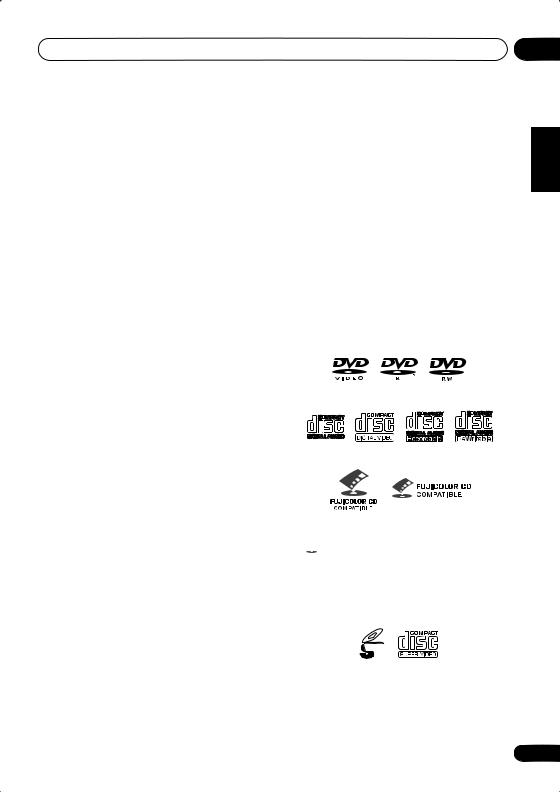
Before you start
Chapter 1
Before you start
Features
•24-bit/96kHz compatible DAC
This system is fully compatible with high sampling-rate discs, capable of delivering exceptional sound quality in terms of dynamic range, low-level resolution and high-frequency detail.
•Surround sound entertainment with Dolby Digital and DTS software
The built-in Dolby Digital and DTS decoders let you enjoy great surround sound with Dolby Digital and DTS discs.
Disc / content format playback compatibility
This player is compatible with a wide range of disc types (media) and formats. Playable discs will generally feature one of the following logos on the disc and/or disc packaging. Note however that some disc types, such as recordable CD and DVD, may be in an unplayable format—see below for further compatibility information.
•Pure Cinema progressive scan video
When connected to a progressive scancompatible TV or monitor using the component video outputs, you can enjoy extremely stable, flicker free images, with the same frame refresh rate as the original movie.
•Picture zoom
See Zooming the screen on page 37.
•MP3 and WMA compatibility
See Compressed audio compatibility on page 8.
•JPEG compatibility
See JPEG file compatibility on page 8.
•Graphical on-screen displays
Setting up and using your DVD home theater system is made very easy using the graphical on-screen displays.
DVD-Video DVD-R DVD-RW
Audio CD Video CD |
CD-R |
CD-RW |
Fujicolor CD
• is a trademark of Fuji Photo Film Co. Ltd.
is a trademark of Fuji Photo Film Co. Ltd.
•Also compatible with KODAK Picture CD
This player supports the IEC’s Super VCD standard for superior picture quality, dual soundtracks, and widescreen support.
• Energy saving design |
VIDEO |
|
This system is designed to use 0.5 W of power |
CD |
|
Super Video CD (Super VCD) |
||
when in standby. |
01
Español Nederlands Italiano Français Deutsch English
7
En
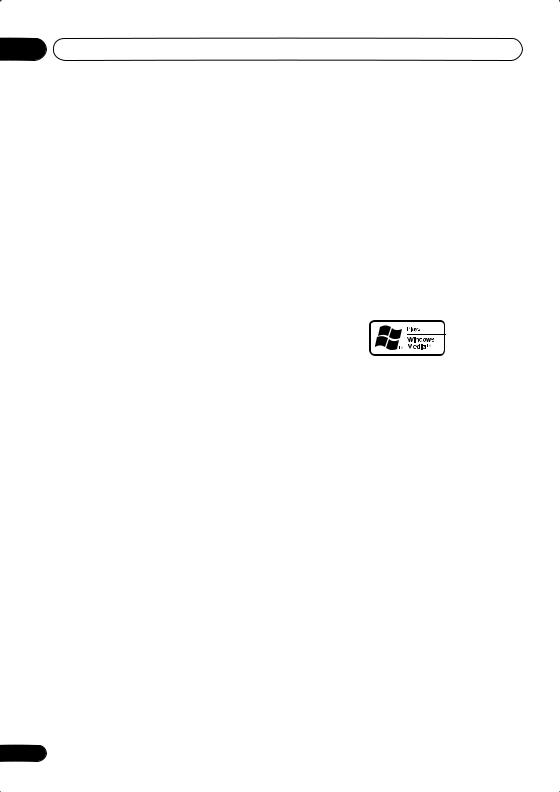
01 Before you start
CD-R/RW compatibility
•Compatible formats: CD-Audio, Video CD/ Super VCD, ISO 9660 CD-ROM* containing MP3, WMA or JPEG files
*ISO 9660 Level 1 or 2 compliant. CD physical format: Mode1, Mode2 XA Form1. Romeo and Joliet file systems are both compatible with this player.
•Multi-session playback: No
•Unfinalized disc playback: Yes
•VBR WMA playback: No
•WMA lossless encoding compatible: No
•DRM (Digital Rights Management) compatible: Yes (DRM-protected audio files will not play in this player). See also DRM in the Glossary on page 69.
•File extensions: .mp3, .wma (these must be used for the player to recognize MP3 and WMA files – do not use for other file types)
•File structure: Up to 999 files per folder
DVD-R/RW compatibility
•Compatible formats: DVD-Video, Video Recording (VR)*
*Edit points may not play exactly as edited; screen may go momentarily blank at edited points.
•Unfinalized playback: No
•WMA/MP3/JPEG file playback on DVD-R/ RW: No
PC-created disc compatibility
Discs recorded using a personal computer may not be playable in this unit due to the setting of the application software used to create the disc. In these particular instances, check with the software publisher for more detailed information.
Discs recorded in packet write mode (UDF format) are not compatible with this player.
Check the DVD-R/RW or CD-R/RW software disc boxes for additional compatibility information.
Compressed audio compatibility
•Compatible formats: MPEG-1 Audio Layer 3 (MP3), Windows Media Audio (WMA)
•Sampling rates: 32, 44.1 or 48kHz
•Bit-rates: Any (128Kbps or higher recommended)
•VBR (variable bit rate) MP3 playback: Yes
8
About WMA
The Windows Media® logo printed on the box indicates that this player can playback Windows Media Audio content.
WMA is an acronym for Windows Media Audio and refers to an audio compression technology developed by Microsoft Corporation. WMA content can be encoded by using Windows
Media® Player version 7, 7.1, Windows Media®
Player for Windows® XP, or Windows Media® Player 9 Series.
Microsoft, Windows Media, and the Windows logo are trademarks, or registered trademarks of Microsoft Corporation in the United States and/ or other countries.
JPEG file compatibility
•Compatible formats: Baseline JPEG and EXIF 2.1* still image files up to 8 megapixels are supported (maximum vertical and horizontal resolution is 5120 pixels). *File format used by digital still cameras
•File extensions: .jpg (must be used for the player to recognize JPEG files – do not use for other file types)
•File structure: Up to 999 files per folder
En
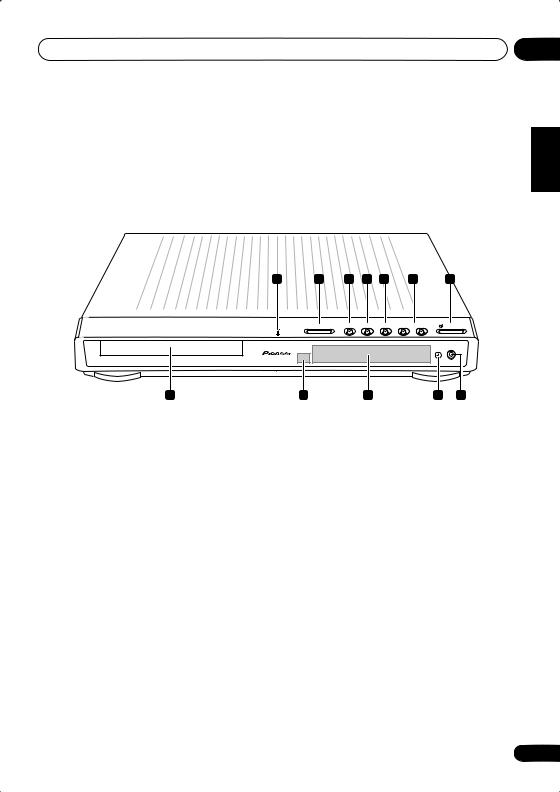
Controls and displays
Chapter 2
Controls and displays
Front panel
1 |
2 |
3 |
4 |
5 |
6 |
|
7 |
|
0 OPEN/CLOSE |
6 DVD/CD |
7 |
FM/AM |
– DOWN VOL. UP + |
|
STANDBY/ON |
|
|
|
|
|
|
|
PHONES |
12 |
11 |
|
10 |
|
|
9 |
8 |
1Operation indicator
2OPEN/CLOSE
Press to open/close the disc tray.
3 DVD/CD
Press to switch to the DVD/CD function. Also press to start/pause/resume playback.
4
Press to stop playback.
5 FM/AM
Press to switch to the tuner function, then to toggle between the FM and AM bands.
6VOLUME buttons
Use to adjust the volume.
7STANDBY/ON
Press to switch the system on or into standby.
8PHONES jack
Headphone jack.
9Timer indicator
Lights when the wake-up timer is set (page 41).
10 Display
See Display on page 10 for detailed information.
11Remote sensor
12Disc tray
02
Español Nederlands Italiano Français Deutsch English
9
En
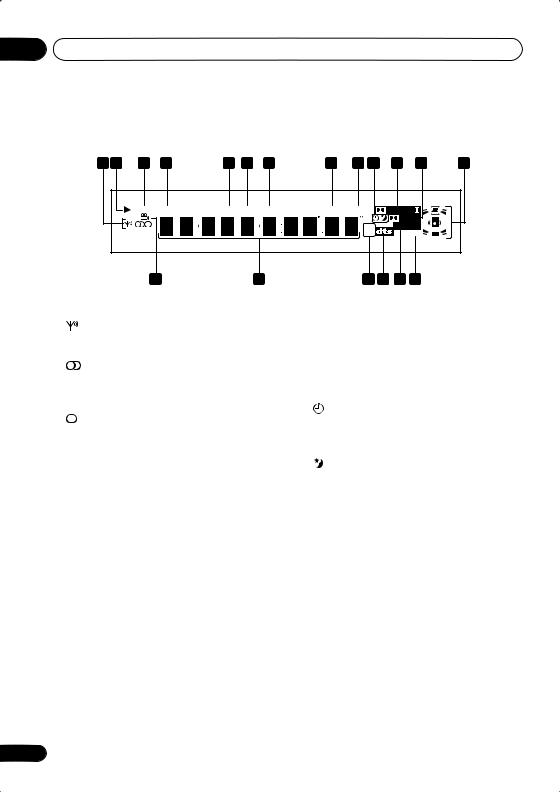
02 Controls and displays
Display |
|
|
|
|
|
|
|
|
|
|
|
|
|
1 |
2 |
3 |
4 |
5 |
6 |
7 |
8 |
9 |
10 |
|
11 |
12 |
13 |
|
|
MIDNIGHT |
QUIET |
PGM |
RPT-1 |
RDM |
ATT |
REC MODE |
PRO LOGIC |
|
|
||
|
|
|
|
|
|
|
|
|
|
|
DIGITAL |
|
|
|
|
|
|
|
|
|
|
|
kHz |
|
ADV.SURR. |
|
|
|
|
|
|
|
|
|
|
|
MHz |
|
PRGSVE |
|
|
|
|
19 |
|
|
18 |
|
|
17 16 |
15 |
14 |
|
||
1Tuner indicators
Lights when a broadcast is being received.
Lights when a stereo FM broadcast is being received in auto stereo mode.
Lights when FM mono reception is selected.
2
Lights when a disc is playing.
3 MIDNIGHT
Lights when the Midnight mode is selected (page 28).
4 QUIET
Lights when the Quiet mode is selected (page 28).
5 PGM
Lights when a program list has been programmed (page 34).
6 RPT and RPT-1
RPT lights during repeat play. RPT-1 lights during repeat one-track play (page 32).
7 RDM
Lights during random play (page 33).
8 ATT
Lights when the input attenuator is active for the currently selected analog input (page 57).
9 REC MODE
Lights when the Rec Mode is on (page 53).
10Timer indicators
Lights when the wake-up timer is set (page 41).
Lights when the sleep timer is active (page 42).
112 PRO LOGIC II
Lights during Dolby Pro Logic II decoding (page 25).
12 2 DIGITAL
Lights during playback of a Dolby Digital source (page 25).
10
En
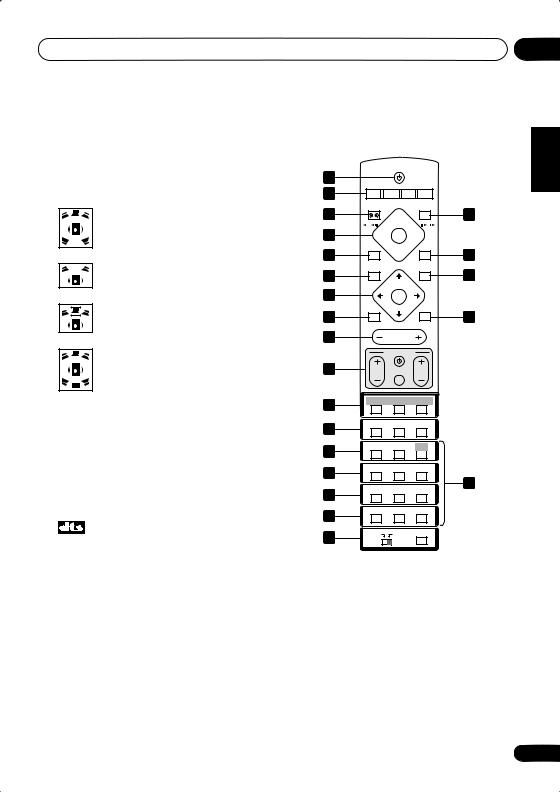
Controls and displays
13 Speaker indicators
These show which speakers are being used to output the current source (they are not placement diagrams). The illustrations below show some example displays.
5.1 channel surround sound
Stereo (2.1 channel) sound
3.1 channel sound with Dialogue enhancement on the center channel
5.1 channel surround sound with Virtual Surround Back mode active
14 PRGSVE
Lights when progressive scan video output is selected (page 48).
15 ADV.SURR.
Lights when one of the Advanced or Front Surround listening modes is selected (page 26).
16
Lights during playback of a DTS source (page 25).
17 kHz / MHz
Indicates the unit of the frequency shown in the character display (kHz for AM, MHz for FM).
18Character display
19
Lights during multi-angle scenes on a DVD disc (page 37).
Remote control
STANDBY/ON
1
2 |
CD |
FM/AM |
L1/L2 |
|
|
DVD |
TUNER TV LINE |
|
|||
|
|
||||
|
FRONT |
|
|
OPEN/CLOSE |
|
3 |
SURROUND |
|
11 |
||
|
|
8 |
0 |
||
4 |
1 |
3 |
¡ |
|
|
5 |
4 |
|
|
4 |
12 |
|
|
7 |
|
||
6 |
DVD MENU |
|
RETURN |
13 |
|
|
|
TUNE+ |
|
||
|
|
|
|
|
|
7 |
ST– |
|
ST+ |
|
|
|
|
ENTER |
|
|
|
8 |
MUTE |
|
TUNE– |
SOUND |
14 |
|
|
|
|
||
9 |
|
|
MASTER |
|
|
|
|
VOLUME |
|
|
|
|
|
TV CONTROL |
|
||
10 |
CH |
|
INPUT |
VOL |
|
15 |
BASS MODE |
DIALOGUE |
CH LEVEL |
|
|
SURROUND |
ADVANCED |
VIRTUAL SB |
|
||
|
|
||||
16 |
PROGRAM |
REPEAT |
RANDOM |
|
|
AUDIO |
|
SUBTITLE |
ANGLE |
|
|
17 |
ZOOM |
|
TOP MENU |
HOME |
|
|
MENU |
|
|||
1 |
|
2 |
3 |
|
|
18 |
SYSTEM |
|
TEST TONE |
QUIET/ |
|
SETUP |
|
MIDNIGHT |
|
||
4 |
|
5 |
6 |
22 |
|
19 |
DIMMER |
|
DISPLAY |
TIMER/ |
|
|
CLOCK |
|
|||
7 |
|
8 |
9 |
|
|
20 |
SR+ |
|
FOLDER– |
FOLDER+ |
|
CLR |
|
0 |
ENTER |
|
|
21 |
MAIN |
|
SUB |
ROOM SETUP |
|
|
|
|
|
|
|
 Important
Important
•Functions printed in green on the remote control are accessed by switching the
MAIN/SUB switch to SUB.
1 STANDBY/ON
Press to switch the system on or into standby.
2 Function select buttons
Press to select the source you want to listen to (DVD (CD). TUNER, TV, LINE)
02
Español Nederlands Italiano Français Deutsch English
11
En

02 Controls and displays
3 FRONT SURROUND
Use to select a Front Surround listening mode (page 26).
4 Disc playback controls
Press to start or resume playback.
and
Use for reverse slow motion playback, frame reverse and reverse scanning.
and
Use for forward slow motion playback, frame advance and forward scanning.
Press to pause playback; press again to restart.
Press to stop playback.
5
Press to jump to the beginning of the current chapter/track, then to previous chapters/ tracks.
6 DVD MENU
Press to display a DVD disc menu, or the Disc Navigator if a VR format DVD-RW, CD, Video CD/Super VCD, MP3, WMA or JPEG disc is loaded.
7 Cursor buttons, ENTER and tuning buttons
Cursor buttons
Use the cursor buttons (/ / /) to navigate on-screen displays and menus.
ENTER
Press to select an option or execute a command.
TUNE +/–
Use to tune the radio.
12
ST +/–
Use to select station presets when listening to the radio.
8MUTE
Press to mute all sound from the speakers and headphones (press again to cancel).
9MASTER VOLUME
Use to adjust the volume.
10TV CONTROL (page 17)
Press to switch the TV on or into standby.
INPUT
Press to switch the TV input.
CH +/–
Use to select channels on the TV.
VOL +/–
Use to adjust the volume on the TV.
11OPEN/CLOSE
Press to open/close the disc tray.
12
Press to jump to the next chapter/track.
13 RETURN
Press to return to a previous menu screen.
14 SOUND
Press to access the sound menu, from which you can adjust the DSP effect level, bass and treble, etc.
15 Surround sound mode/sound enhancement buttons
SURROUND
Use to select a Surround mode (page 25).
ADVANCED
Use to select an Advanced Surround mode (page 26).
VIRTUAL SB
Press to switch the Virtual Surround Back speaker effect on/off (page 28).
En

Controls and displays |
02 |
BASS MODE
Use to select a Bass Mode (page 29).
DIALOGUE
Use to select a Dialogue mode (page 28).
CH LEVEL
Use to adjust the speaker level (page 45).
16DVD/CD buttons
AUDIO
Press to select an audio channel or language (page 36).
SUBTITLE
Press to display/change the DVD subtitle display (page 36).
ANGLE
Press to change camera angle during DVD multi-angle scene playback (page 37).
PROGRAM
Use to program/play a program list (page 34–35).
REPEAT
Use to select a repeat play mode (page 32).
RANDOM
Use to select a random play mode (page 33).
17ZOOM
Press to change the screen zoom level (page 37).
TOP MENU
Use to display the top menu of a DVD disc in the play position (this may be the same as pressing DVD MENU).
HOME MENU
Press to display (or exit) the on-screen menu for Initial Settings, Play Mode functions, etc.
18SYSTEM SETUP
Use to make various system and surround sound settings (page 43).
TEST TONE
Use to output the test tone (for speaker setup) (page 45).
QUIET/MIDNIGHT
Use to select the Quiet and Midnight modes (page 28).
19DIMMER
Press to switch between normal and dimmed front panel display.
DISPLAY
Press to display/change disc information shown on-screen (page 37).
TIMER/CLOCK
Press to display the clock and to access the timer menu (page 15 and page 41).
20SR+
Press to switch the SR+ mode on/off (page 56).
FOLDER –
Press to jump to previous folders.
FOLDER +
Press to jump to the next folder.
CLR
Press to clear an entry.
ENTER
Selects menu options, etc. (works exactly the same as the ENTER button in 7 above).
21MAIN/SUB
Change from MAIN to SUB to access the functions/commands printed in green on the remote.
ROOM SETUP
Press to start Room Setup (page 16).
22 Number buttons
Use the number buttons for selecting chapters/tracks from a disc directly.
Español Nederlands Italiano Français Deutsch English
13
En
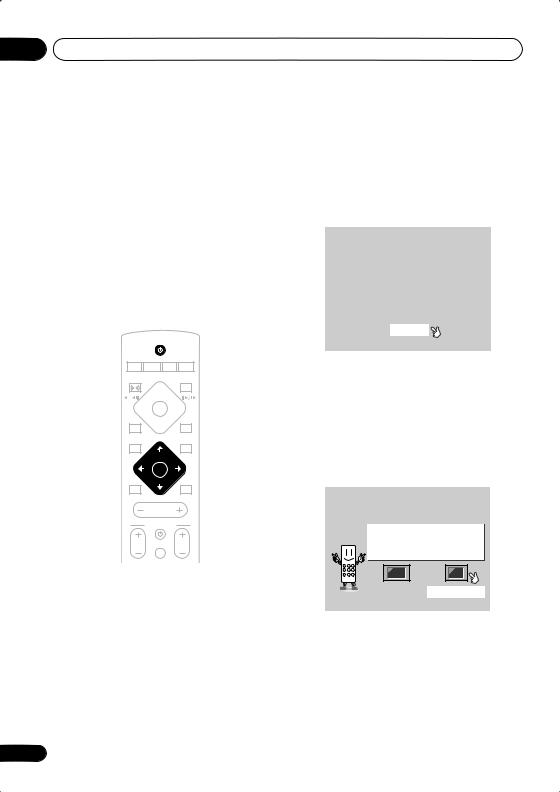
03 Getting started
Chapter 3
Getting started
Switching on and setting up
After making sure everything is connected up properly, you’re ready to switch on. The first thing to do is to tell the system what kind of TV you’re using, standard or widescreen.
After that you can set up the surround sound for your room, and set the clock so that you can use the timer features.
|
|
STANDBY/ON |
|
CD |
FM/AM |
L1/L2 |
|
DVD |
TUNER TV |
LINE |
|
FRONT |
|
|
OPEN CLOSE |
SURROUND |
|
||
|
|
8 |
0 |
1 |
3 |
¡ |
|
4 |
|
|
4 |
|
|
7 |
|
DVD MENU |
|
RETURN |
|
|
|
TUNE+ |
|
|
ST– |
ST+ |
|
|
|
ENTER |
|
MUTE |
|
TUNE– |
SOUND |
|
|
MASTER |
|
|
|
VOLUME |
|
|
TV CONTROL |
||
CH |
|
INPUT |
VOL |
1 Press STANDBY/ON (on the remote or the front panel) to switch the system on.
Also make sure that your TV is switched on and that the video input is set to this system (for example, if you connected this system to the VIDEO 1 input on your TV, switch your TV to
VIDEO 1).
14
You should see the welcome screen displayed.
Welcome to Pioneer DVD!
Thank you for purchasing this Pioneer DVD player.
Before using, please take a little time to setup your DVD player
Put the batteries into the remote control
Next, press the [ENTER] button on the remote control and start the Let's Get Started Menu
Next
2Press ENTER to move on to the next screen.
3Use the /(cursor left/right) buttons to select either ‘Wide screen (16:9)’ or ‘Standard size screen (4:3)’ according to the kind of TV you have, then press ENTER.
See also Screen sizes and disc formats on page 66 if you’re not sure which one to choose.
Let's Get Started Menu
What kind of TV do you have? Use the  /
/ cursor buttons to choose, then press [ENTER]
cursor buttons to choose, then press [ENTER]
Wide screen (16:9) Standard size screen (4:3)
En
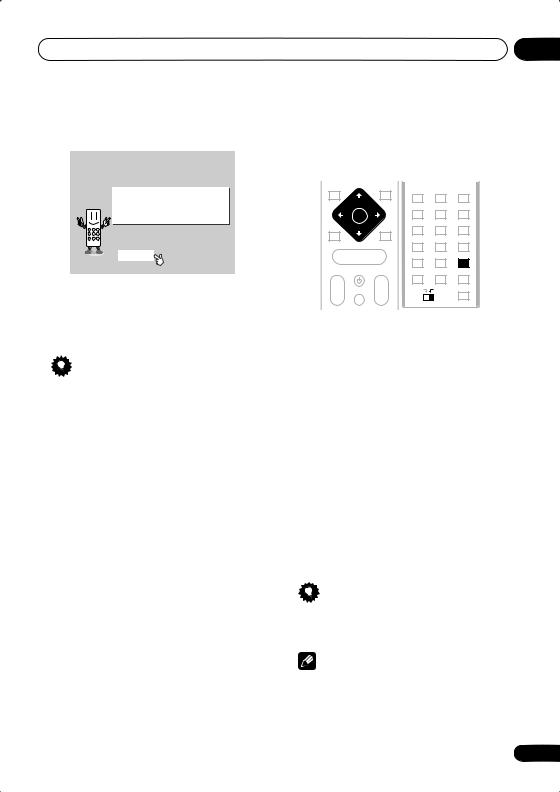
Getting started |
03 |
4 Press ENTER again to finish setting up.
Let's Get Started Menu
Setup complete
If you're finished setting up, choose [Complete],
to start again choose [Back]
Complete |
Back |
•Use the (cursor right) button to select Back then press ENTER if you want to go back and change the setting you just made.
Tip
• You can also use the function buttons (DVD/CD, TUNER, etc.) or the OPEN/ CLOSE button to switch the system on from standby.
Setting the clock |
|
|
|
|
|
|
|
|
|
English |
|||||||||||||||
Setting the clock allows you to use the timer |
|||||||||||||||||||||||||
|
|||||||||||||||||||||||||
features. |
|
|
|
|
|
|
|
|
|
|
|
|
|
|
|||||||||||
|
|
|
|
|
|
|
|
|
|
|
|
|
|
|
|
|
|
|
|
|
|
|
|||
|
|
DVD |
|
|
|
|
|
|
|
|
|
|
|
||||||||||||
|
|
|
|
|
|
|
BASS MODE DIALOGUE |
VIRTUALCHLEVELSB |
|
|
|
||||||||||||||
|
|
|
|
|
|
|
|
|
|
|
|
|
|
|
|
SURROUND SURROUNDADVANCE VIRTUALADVANCEDSB |
|
|
|
||||||
|
|
|
|
|
|
|
|
|
|
|
|
|
|
|
|
PROGRAM |
REPEAT |
RANDOM |
|
|
|
||||
|
|
|
|
|
|
|
|
|
|
|
|
|
|
|
|
AUDIO |
SUBTITLE |
|
ANGLE |
|
|
Deutsch |
|||
|
|
|
|
|
|
|
|
VOLUME |
|
|
|
|
|
|
|
|
|
|
|
|
|
||||
|
|
|
|
|
|
|
|
ENTER |
|
|
|
|
|
|
|
|
|
|
|
|
|
|
|||
|
|
|
|
|
|
|
|
|
|
|
|
|
|
|
|
ZOOM |
TOP MENU |
|
HOME |
|
|
|
|
|
|
|
|
|
|
|
|
|
|
|
|
|
|
|
|
|
|
|
MENU |
|
|
|
|
|
|||
|
|
|
|
|
|
|
|
|
|
|
|
|
|
|
1 |
2 |
3 |
|
|
|
|
|
|||
|
|
|
|
|
|
|
|
|
|
|
|
|
|
|
|
SYSTEM |
TEST TONE |
|
QUIET/ |
|
|
|
|||
|
|
|
|
|
|
|
|
|
|
|
|
|
|
|
|
SETUP |
MIDNIGHT |
|
|
|
|||||
|
|
|
|
|
|
|
|
|
|
|
|
|
|
|
4 |
5 |
6 |
|
|
|
|
|
|||
|
|
|
|
|
|
|
|
MASTER |
|
|
|
|
|
|
|
DIMMER |
|
|
TIMER/ |
|
|
|
|||
|
|
|
|
|
|
|
|
|
|
|
|
|
|
|
|
DISPLAY |
|
CLOCK |
|
|
|
||||
|
|
|
|
|
|
|
|
|
|
|
|
|
|
|
7 |
8 |
9 |
|
|
|
|
|
|||
|
|
|
|
|
|
|
|
TV CONTROL |
|
|
|
|
|
|
SR+ |
FOLDER– |
FOLDER+ |
|
|
||||||
|
|
|
|
|
|
|
|
|
|
|
|
|
|
||||||||||||
|
|
|
|
|
|
|
|
|
|
|
|
|
|
|
|
CLR |
0 |
|
ENTER |
|
|
|
|||
|
|
|
CH INPUT VOL |
|
|
MAIN |
SUB |
ROOM SETUP |
|
|
Français |
||||||||||||||
|
|
|
|
|
|
|
|
|
|
|
|
|
|
|
|
|
|
|
|
|
|
|
|
|
|
|
|
|
|
|
|
|
|
|
|
|
|
|
|
|
|
|
|
|
|
|
|
|
|
|
|
|
|
|
|
|
|
|
|
|
|
|
|
|
|
|
|
|
|
|
|
|
|
|
|
|
|
1 |
Press TIMER/CLOCK. |
|
|
|
|
|
|
|
|
||||||||||||||||
|
• If you are adjusting the clock, rather then |
|
|
||||||||||||||||||||||
|
|
|
|||||||||||||||||||||||
|
setting it for the first time, press TIMER/ |
|
|||||||||||||||||||||||
|
CLOCK again. |
|
|
|
|
|
|
|
|
|
|
|
|
|
Italiano |
||||||||||
the display, press |
or (cursor left or |
||||||||||||||||||||||||
2 If ‘Clock ADJ?’ isn’t already showing in |
|
||||||||||||||||||||||||
right) until you see it. |
|
|
|
|
|
|
|
|
|
|
|||||||||||||||
3 |
Press ENTER. |
|
|
|
|
|
|
|
|
|
|
|
|
|
|
||||||||||
|
|
|
|
|
|
|
|
|
|
|
|
|
Nederlands |
||||||||||||
4 Use the / (cursor up/down) buttons |
|
||||||||||||||||||||||||
|
|
||||||||||||||||||||||||
to set the hour. |
|
|
|
|
|
|
|
|
|
|
|
|
|
|
|||||||||||
5 |
Press ENTER. |
|
|
|
|
|
|
|
|
|
|
|
|
|
|
||||||||||
6 Use the / (cursor up/down) buttons |
Español |
||||||||||||||||||||||||
to set the minute. |
|
|
|
|
|
|
|
|
|
|
|
|
|
||||||||||||
|
|
|
|
|
|
|
|
|
|
|
|
|
|
||||||||||||
7 Press ENTER to confirm.
The display flashes to indicate the clock is set.
Tip
•Press TIMER/CLOCK anytime to display the clock.
Note
•If you unplug the system from the wall outlet, or there is a power outage, you will need to set the clock again.
15
En
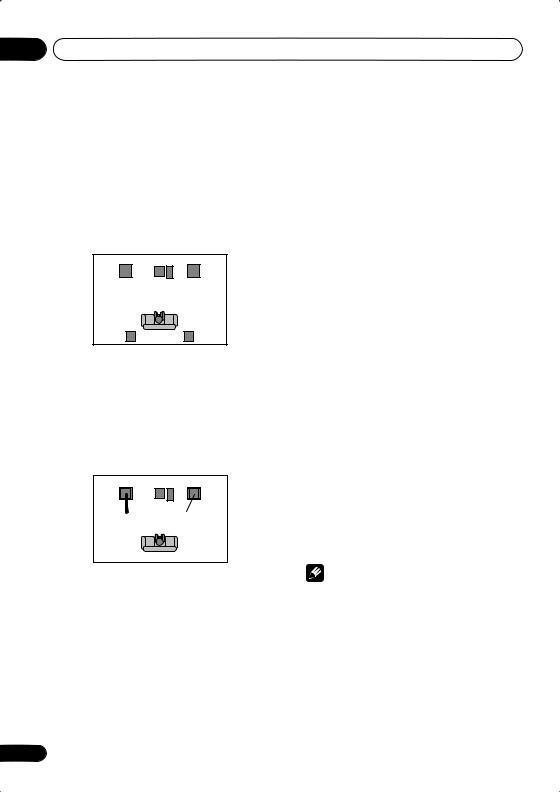
03 Getting started
Home theater sound setup
Depending on the size and characteristics of your room, you can choose to place your speakers in one of two ways using this system:
•Standard surround 5-spot setup – This is a standard multichannel surround sound speaker setup for optimal 5.1 channel home theatre sound.
Front left |
Center |
Front right |
|
Subwoofer |
|
Listening position |
|
|
Surround |
|
Surround |
left |
|
right |
•Front surround 3-spot setup – This setup is ideal when rear surround speaker placement isn't possible or you want to avoid running long speaker cables in your listening area. Use this setup together with the Front Surround modes to take advantage of wall and ceiling reflections for a very realistic surround effect.
Center
Front |
Front |
left |
right |
Subwoofer
Surround |
Surround |
left |
right |
Listening position
See About the listening modes on page 24 for more on using the different listening modes with each speaker setup.
Using the Room Setup
After you have set up your speakers to your liking (see Home theater sound setup above), make sure you calibrate your system for surround sound. This is a quick and easy way to get good surround sound for your room.
16
For a more detailed surround sound setup, see
Using the System Setup menu on page 43.
1If the system isn’t already on, press STANDBY/ON to switch it on.
2Press ROOM SETUP.
•If you have previously set up the room type and seating position, the display will show the current room settings.
3Press ENTER.
4Use the / (cursor up/down) buttons to select a room type then press ENTER.
Choose one of the following depending on your room size:
•S – Smaller than average room
•M – Average room
•L – Larger than average room
5Use the / (cursor up/down) buttons to select a seating position setting, then press ENTER.
Choose one of the following depending on where your main listening position is:
•Fwd – If you are nearer to the front speakers than the surround speakers
•Mid – If you are equal distance from the front and surround speakers
•Back – If you are nearer to the surround speakers than the front speakers
Note
•The Room Setup automatically sets up both channel level and channel delay. If you have already set the channel levels manually (see Setting the channel levels on page 45), you will see Room Set? in the display when you first press the ROOM SETUP button.
En
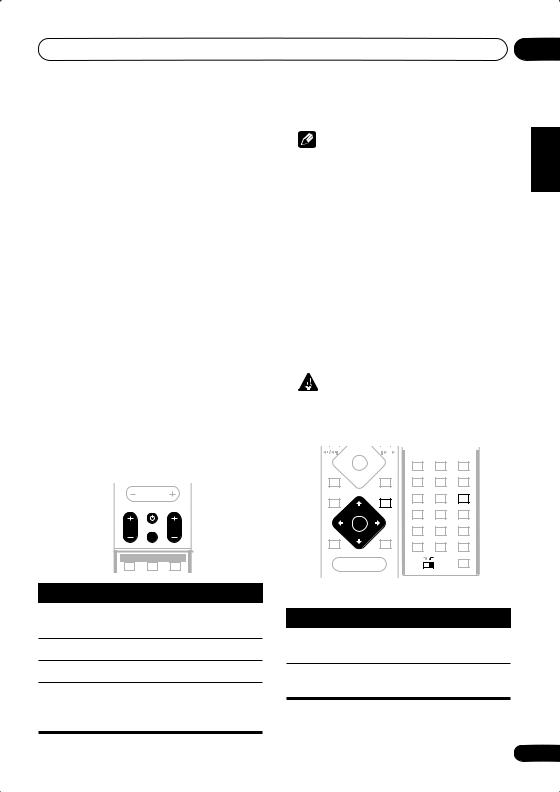
Getting started
Setting up the remote to control your TV
You can set up the supplied remote to control your TV using the TV CONTROL buttons.
1Switch on your TV.
2Find the name of the manufacturer of your TV in the Preset code list on page 68.
Next to each manufacturer is one or more three digit codes. These tell the remote what kind of TV you have.
If the name of the manufacturer of your TV does not appear in the table, you won’t be able to set up this remote to control your TV.
3 Point the remote at your TV, hold down the CLR button, then enter the three digit code for your TV.
The remote transmits an on/off signal to the TV. If you’ve entered the correct code, your TV should switch off.
If your TV doesn’t turn off, repeat the procedure using the next code in the list until your TV switches off successfully. Once set, you can use the individual TV controls shown below.
MASTER
VOLUME
 TV CONTROL
TV CONTROL 
|
CH |
INPUT |
VOL |
|
BASS MODE DIALOGUE |
CH LEVEL |
|
|
SURROUND |
ADVANCED VIRTUAL SB |
|
|
PROGRAM |
REPEAT |
RANDOM |
Button |
What it does |
||
Switches your TV on or into standby.
CH +/– Changes the TV channel.
VOL +/– Adjusts the volume.
INPUT Switches the TV’s input between the built in TV tuner and an external video source.
03
Note |
English |
|
• The default setting is for a Pioneer TV. |
||
|
Using the on-screen displays
For ease of use, this system makes extensive |
|
Deutsch |
|||||||||||||||||||||
use of graphical on-screen displays (OSDs). |
|
||||||||||||||||||||||
|
|
||||||||||||||||||||||
You should get used to the way these work as |
|
|
|||||||||||||||||||||
you’ll need to use them when setting up the |
|
|
|||||||||||||||||||||
system, using some of the playback features, |
|
|
|||||||||||||||||||||
|
|
||||||||||||||||||||||
such as program play, and when making more |
|
||||||||||||||||||||||
Français |
|||||||||||||||||||||||
advanced settings for audio and video. |
|||||||||||||||||||||||
|
|||||||||||||||||||||||
All the screens are navigated in basically the |
|
||||||||||||||||||||||
same way, using the cursor buttons ( , , , |
|
||||||||||||||||||||||
) to change the highlighted item and |
|
||||||||||||||||||||||
pressing ENTER to select it. |
|
|
|
|
|
|
|
|
|||||||||||||||
|
|
|
|
|
|
|
|
|
|
|
|
|
|
|
Italiano |
||||||||
• |
|
Throughout this manual, ‘Select’ means |
|||||||||||||||||||||
|
|
|
Important |
|
|
|
|
|
|
|
|
|
|
|
|||||||||
|
use the cursor buttons to highlight an item |
|
|||||||||||||||||||||
|
|||||||||||||||||||||||
|
on-screen, then press ENTER. |
|
|
|
|
|
|
|
|||||||||||||||
|
|
|
|
|
|
Nederlands |
|||||||||||||||||
|
|
|
|
|
|
|
|
|
|
|
|
|
|
|
|
|
|
|
|
|
|
||
|
|
|
|
|
|
|
|
|
|
|
|
|
|
|
|
|
|
|
|
||||
|
|
|
|
|
|
|
|
|
|
|
|
|
|
BASS MODE DIALOGUE |
|
HOME |
|
|
|
||||
|
|
|
|
|
|
|
|
|
|
|
|
|
|
CH LEVEL |
|
|
|
|
|||||
|
|
|
1 |
3 ¡ |
|
|
|
SURROUND ADVANCED |
VIRTUAL SB |
|
|
|
|
||||||||||
|
|
|
4 |
|
|
4 |
|
|
|
PROGRAM |
REPEAT |
RANDOM |
|
|
|
||||||||
|
|
|
|
|
|
AUDIO |
SUBTITLE |
|
ANGLE |
|
|
|
|||||||||||
|
|
|
|
|
|
|
|
7 |
|
|
|
|
|
|
|
|
|
|
|
|
|
|
|
|
|
|
|
|
|
|
|
|
|
|
|
|
|
ZOOM |
TOP MENU |
|
|
|
|
|
|
||
|
|
|
DVD |
|
|
|
|
|
|
|
MENU |
|
|
|
|
|
|||||||
|
|
|
|
|
|
|
|
1 |
2 |
|
3 |
|
|
|
|
|
|||||||
|
|
|
|
|
|
|
|
|
|
|
|
|
|
SYSTEM |
|
|
QUIET/ |
|
|
|
|
||
|
|
|
|
|
|
|
|
|
|
|
|
|
|
SETUP |
TEST TONE |
MIDNIGHT |
|
Español |
|||||
|
|
|
|
|
|
|
|
|
|
|
|
|
4 |
5 |
6 |
|
|
|
|
||||
|
|
|
|
|
|
|
|
|
|
|
|
|
|
MAIN |
SUB |
ROOM SETUP |
|
||||||
|
|
|
|
|
|
|
|
ENTER |
|
|
DIMMER |
DISPLAY |
|
TIMER/ |
|
|
|||||||
|
|
|
|
|
|
|
|
|
|
|
CLOCK |
|
|
||||||||||
|
|
|
|
|
|
|
|
|
|
|
|
|
7 |
8 |
9 |
|
|
|
|
|
|||
|
|
|
|
|
|
|
|
|
|
|
|
|
|
SR+ |
FOLDER– |
FOLDER+ |
|
|
|||||
|
|
|
|
|
|
|
|
|
|
|
|
|
|
CLR |
0 |
|
ENTER |
|
|
||||
|
|
|
|
|
|
|
|
MASTER |
|
|
|
|
|
|
|
|
|
|
|
|
|
|
|
|
|
|
|
|
|
|
|
VOLUME |
|
|
|
|
|
|
|
|
|
|
|
|
|
|
|
|
|
|
|
|
|
|
|
|
|
|
|
|
|
|
|
|
|
|
|
|
|||
|
|
|
|
|
|
|
|
|
|
|
|
|
|
|
|
|
|
|
|
|
|
|
|
Button |
What it does |
|
|
|
|
|
|
|
|
||||||||||||||
HOME |
Displays/exits the on-screen |
|
|||||||||||||||||||||
MENU |
display |
|
|
|
|
|
|
|
|
|
|
|
|||||||||||
Changes the highlighted menu item
17
En
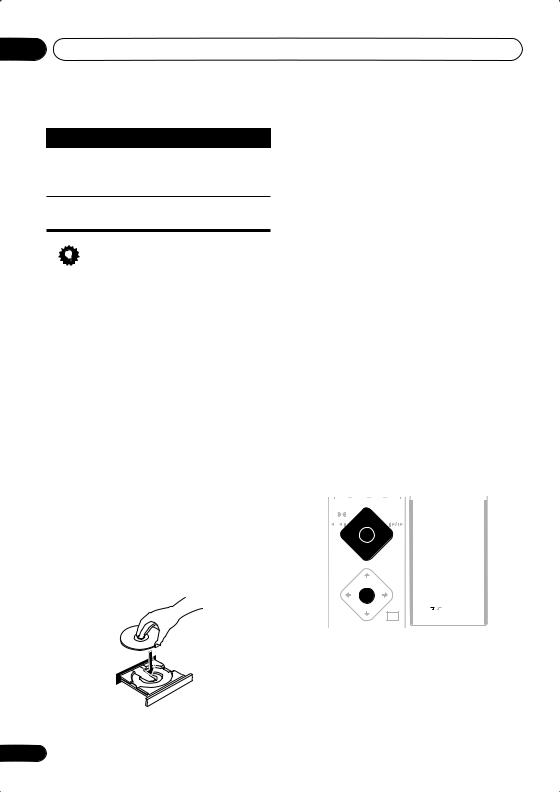
03 Getting started
Button |
What it does |
ENTER Selects the highlighted menu item (both ENTER buttons work in exactly the same way)
RETURN Returns to the main menu without saving changes
Tip
•The button guide at the bottom of every OSD screen shows you which buttons you’ll need to use for that screen.
Playing discs
The basic playback controls for playing DVD, CD, Video CD/Super VCD and WMA/MP3 discs are covered here. Further functions are detailed in chapter 5.
1 If the player isn’t already on, press STANDBY/ON to switch it on.
If you’re playing a DVD or Video CD/Super VCD, also turn on your TV and make sure that it is set to the correct video input.
2 Press OPEN/CLOSE to open the disc tray.
3 Load a disc.
Load a disc with the label side facing up, using the disc tray guide to align the disc (if you’re loading a double-sided DVD disc, load it with the side you want to play face down).
4 Press (play) to start playback.
If you’re playing a DVD or Video CD/Super VCD, a menu may appear. See DVD-Video disc menus on page 20 and Video CD/Super VCD PBC menus on page 21 for how to navigate these.
If you’re playing an WMA/MP3 disc, it may take a few seconds before playback starts, depending on the complexity of the file structure on the disc.
If you loaded a CD/CD-R/RW containing JPEGs, a slideshow will start. See Viewing JPEG discs on page 39 for more on playing these discs.
•See also Options on page 50 if the disc contains both WMA/MP3 audio files and JPEG picture files.
5 Use the MASTER VOLUME – / + button (or the front panel VOLUME buttons) to adjust the volume.
Basic playback controls
The following table shows the basic controls on the remote for playing discs. You can find other playback features in the chapter 5.
|
|
FRONT |
|
|
|
|
|
|
|
|
|
|
|
|
|
|
|
|
|
|
|
|
|
|
|
|
|
|
|
|
|
|
|
|
|
|
|
|
|
||
SURROUND |
|
|
CLOSE |
|
BASS MODE |
DIALOGUE |
CH LEVEL |
|
||||||||||||
|
|
|
|
8 |
|
|
|
|
|
SURROUND |
ADVANCED |
VIRTUAL SB |
|
|||||||
|
|
|
|
|
|
|
|
|
|
|
|
|
|
|
|
|
|
|
|
|
|
|
|
|
|
|
|
|
|
|
|
|
|
|
|
|
|
|
|
|
|
|
|
|
|
|
|
|
|
|
|
|
PROGRAM |
|
|
REPEAT |
RANDOM |
|||||
|
|
|
|
|
|
|
|
|
|
|
AUDIO |
|
SUBTITLE |
|
ANGLE |
|||||
1 |
3 |
¡ |
|
|
|
|
|
|
|
|
|
|
|
|
|
|
||||
|
|
|
|
|
|
|
|
|
|
|
ZOOM |
TOP MENU |
|
HOME |
|
|
||||
|
|
|
|
|
|
|
|
|
|
|
|
MENU |
|
|
||||||
4 |
|
|
4 |
|
|
|
|
1 |
|
|
2 |
|
|
3 |
|
|
||||
|
|
|
|
7 |
|
|
|
|
|
|
|
|
|
|
|
|
|
|
|
|
|
|
|
|
|
|
|
|
|
SYSTEM |
|
|
|
|
|
QUIET/ |
|||||
|
|
|
|
|
|
|
|
|
|
|
SETUP |
TEST TONE |
MIDNIGHT |
|||||||
|
|
|
|
|
|
|
|
|
||||||||||||
DVD MENU |
|
RETURN |
|
|
4 |
|
|
5 |
|
|
6 |
|
|
|||||||
|
|
DIMMER |
|
DISPLAY |
|
TIMER/ |
||||||||||||||
|
|
|
|
|
|
|
|
|
|
|
|
CLOCK |
||||||||
|
|
|
|
TUNE+ |
|
|
|
|
|
|
7 |
|
|
8 |
|
|
9 |
|
|
|
|
|
|
ST– |
ST+ |
||||||||||||||||
|
|
|
|
|
|
SR+ |
|
FOLDER– |
FOLDER+ |
|||||||||||
|
|
|
|
ENTER |
|
|
|
|
|
|
CLR |
|
|
0 |
|
|
ENTER |
|
|
|
|
|
MUTE |
TUNE– |
SOUND |
|
|
MAIN |
|
SUB |
ROOM SETUP |
||||||||||
|
|
|
|
|
|
|
|
|
|
|
|
|
|
|
|
|
|
|
|
|
|
|
|
|
|
|
|
|
|
|
|
|
|
|
|
|
|
|
|
|
|
18
En

Getting started |
03 |
Button |
What it does |
|
|
Starts playback. |
|
|
DVD and Video CD: If the display |
|
|
shows Resume or Last Mem |
|
|
playback starts from the resume |
|
|
or last memory point (see also |
|
|
Resume and Last Memory |
|
|
below.) |
|
|
|
|
|
Pauses a disc that’s playing, or |
|
|
restarts a paused disc. |
|
|
|
|
|
Stops playback. |
|
|
DVD and Video CD: The display |
|
|
shows Resume. Press again if |
|
|
you want to cancel the resume |
|
|
function. (See also Resume and |
|
|
Last Memory below.) |
|
|
|
|
|
Press to start fast reverse |
|
|
scanning. Press |
(play) to |
|
resume normal playback. |
|
|
|
|
|
Press to start fast forward |
|
|
scanning. Press |
(play) to |
|
resume normal playback. |
|
Skips to the start of the current track or chapter, then to previous tracks/chapters.
Skips to the next track or chapter.
FOLDER +/– Skips to the next/previous folder when playing an WMA/MP3 disc.
Button |
What it does |
Numbers • If the disc is stopped, playback starts from the selected title (for DVD) or track number (for CD/ Video CD/Super VCD/WMA/ MP3) after a few seconds (or after pressing ENTER).
• If the disc is playing, playback jumps to the start of the selected chapter or track after a few seconds (or after pressing
ENTER).
 Note
Note
•You may find with some DVD discs that some playback controls don’t work in certain parts of the disc. This is not a malfunction.
•Track skip and number buttons for track selection do not work with unfinalized CD- R/RW discs.
Using the front panel controls
The |
OPEN/CLOSE, |
DVD/CD, FM/AM |
and |
(stop) buttons work the same way as the |
|
remote control equivalents.
Resume and Last Memory
When you stop playback of a DVD or Video CD disc, Resume shows in the display indicating that you can resume playback from that point. If the disc tray is not opened, the next time you start playback the display shows Resume and playback resumes from the resume point.
For DVD discs only: If you take the disc out of the player, the play position is stored in memory. When you load the disc next time, the display shows Last Mem and you can resume playback (this works for up to five discs).
If you want to clear the resume/last memory point, press (stop) while Resume or Last Mem is displayed.
Español Nederlands Italiano Français Deutsch English
19
En
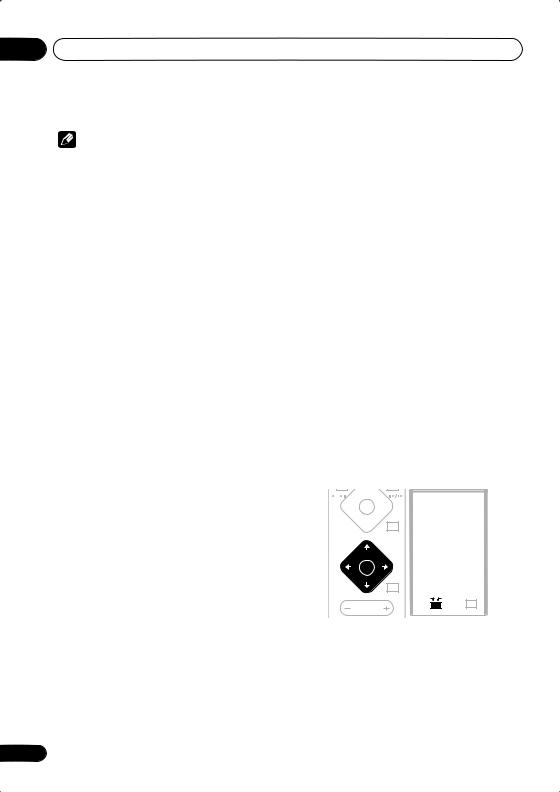
03 Getting started
Note
•When a Video CD is loaded, the Resume point is lost if the system is switched off, or switched to a function other than DVD (CD).
•For the Last Memory function to work, you
must press (stop) to stop playback before opening the disc tray.
•The Last Memory function doesn’t work with VR format DVD-RW discs.
 FAQ
FAQ
•After I load a DVD disc, it ejects automatically after a few seconds!
Most likely, the disc is the wrong region for your system. The region number should be printed on the disc; check it against the region number of the system (which you can find on the rear panel). See also DVD Video regions on page 58.
If the region number is OK, it may be that the disc is damaged or dirty. Clean the disc and look for signs of damage. See also
Using and taking care of discs on page 58.
•Why won’t the disc I loaded play?
First check that you loaded the disc the right way up (label side up), and that it’s clean and not damaged. See Using and taking care of discs on page 58 for information on cleaning discs.
If a disc loaded correctly won’t play, it’s probably an incompatible format or disc type, such as DVD-Audio or DVD-ROM. See
Disc / content format playback compatibility on page 7 for more on disc compatibility.
•I have a widescreen TV so why are there black bars at the top and bottom of the screen when I play some discs?
Some movie formats are such that even when played on a widescreen TV, black bars are necessary at the top and bottom of the screen. This is not a malfunction.
•I have a standard (4:3) TV and set the system to show widescreen DVDs in pan & scan format, so why do I still get black bars top and bottom with some discs?
Some discs override the display preferences of the system, so even if you have 4:3 (Pan & Scan) selected, those discs will still be shown in letterbox format. This is not a malfunction.
DVD-Video disc menus
Many DVD-Video discs contain menus from which you can select what you want to watch. They may give access to additional features, such as subtitle and audio language selection, or special features such as slideshows. See the disc packaging for details.
Sometimes DVD-Video menus are displayed automatically when you start playback; others only appear when you press DVD MENU or
TOP MENU.
|
|
|
|
|
|
|
BASS MODE |
DIALOGUE |
CH LEVEL |
||||||
|
|
|
|
|
|
|
SURROUND |
ADVANCED |
VIRTUAL SB |
||||||
1 |
3 |
¡ |
|
|
|
|
|
|
|
|
|
|
|||
|
|
|
|
|
|
|
|
|
|
|
|
|
|
|
|
|
|
|
|
|
|
|
|
PROGRAM |
|
|
REPEAT |
|
|
RANDOM |
|
4 |
|
|
4 |
|
|
AUDIO |
SUBTITLE |
|
ANGLE |
||||||
|
|
|
7 |
|
|
|
|
|
|
|
|
|
|
|
|
|
|
|
|
|
|
|
|
ZOOM |
TOP MENU |
|
HOME |
|
|||
|
|
|
|
|
|
|
|
|
MENU |
|
|||||
DVD |
|
|
|
|
|
1 |
|
|
2 |
|
|
3 |
|
||
|
|
|
|
|
|
|
|
|
|
|
|
|
|
|
|
|
|
|
|
|
|
SYSTEM |
TEST TONE |
QUIET/ |
|||||||
|
|
|
|
|
|
|
|
SETUP |
MIDNIGHT |
||||||
|
|
|
|
|
|
|
|
4 |
|
|
5 |
|
|
6 |
|
|
|
|
|
|
|
|
DIMMER |
DISPLAY |
|
TIMER/ |
|
||||
|
|
|
ENTER |
|
|
|
|
CLOCK |
|||||||
|
|
|
|
|
|
|
|
7 |
|
|
8 |
|
|
9 |
|
|
|
|
|
|
|
|
|
SR+ |
FOLDER– |
FOLDER+ |
|||||
|
|
|
|
|
|
|
|
CLR |
|
|
0 |
|
|
ENTER |
|
|
|
|
|
|
|
|
|
MAIN |
SUB |
ROOM SETUP |
|||||
MASTER
VOLUME
20
En
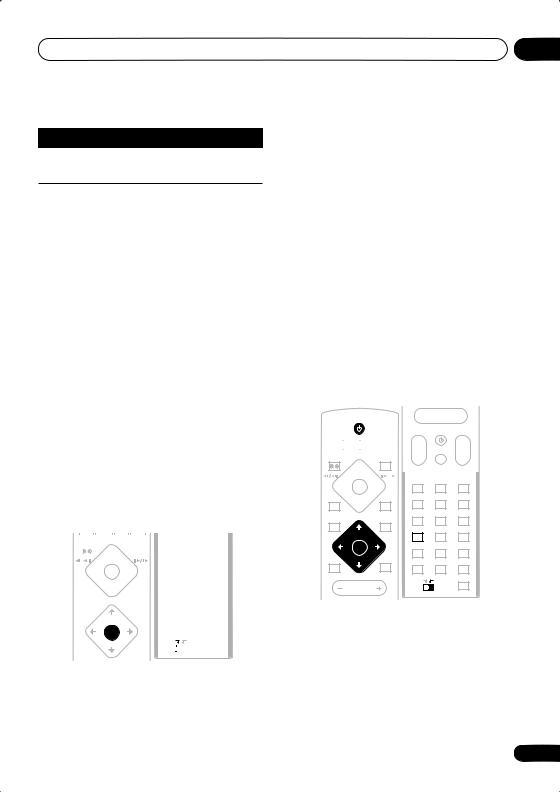
Getting started |
03 |
Button |
What it does |
TOP MENU Displays the ‘top menu’ of a DVD disc—this varies with the disc.
DVD |
Displays a DVD disc menu—this |
MENU |
varies with the disc and may be |
|
the same as the ‘top menu’. |
|
|
|
Moves the cursor around the |
|
screen. |
|
|
ENTER |
Selects the current menu option. |
|
|
RETURN |
Returns to the previously |
|
displayed menu screen. |
|
|
Numbers |
Highlights a numbered menu |
|
option (some discs only). Press |
|
ENTER to select. |
|
|
Video CD/Super VCD PBC menus
Some Video CD/Super VCDs have menus from which you can choose what you want to watch. These are called PBC (Playback control) menus.
You can play a PBC Video CD/Super VCD without having to navigate the PBC menu by pressing (stop) then starting playback using a number button to select a track, rather than
(play) (or |
|
on the front panel). |
||||||||||||||||||
|
|
|
|
|
|
|
|
|
|
|
|
|
|
|
|
|
|
|
|
|
|
|
|
|
|
|
|
|
|
|
|
|
|
|
|
|
|
|
|
||
|
|
|
FRONT |
|
|
|
|
|
|
|
BASS MODE |
DIALOGUE |
CH LEVEL |
|||||||
|
SURROUND |
|
OPEN CLOSE |
|
|
SURROUND |
ADVANCED |
|
VIRTUAL SB |
|
||||||||||
|
|
|
|
|
8 |
|
0 |
|
|
|
|
|
|
|
|
|
|
|
|
|
|
|
|
|
|
|
|
|
|
|
|
|
PROGRAM |
REPEAT |
RANDOM |
||||||
|
|
|
|
|
|
|
|
|
|
|
|
AUDIO |
SUBTITLE |
|
ANGLE |
|||||
|
1 |
3 |
¡ |
|
|
|
|
|
|
|
|
|
|
|
|
|
||||
|
|
|
|
|
ZOOM |
TOP MENU |
|
HOME |
|
|
||||||||||
|
|
|
|
|
|
|
|
|
|
|
|
|
MENU |
|
||||||
|
4 |
|
|
4 |
|
|
|
|
1 |
|
|
2 |
|
|
3 |
|
|
|||
|
|
|
|
|
7 |
|
|
|
|
|
|
SYSTEM |
|
|
TEST TONE |
|
QUIET/ |
|
|
|
|
|
|
|
|
|
|
|
|
|
|
|
SETUP |
|
MIDNIGHT |
||||||
|
|
|
|
|
|
|
|
|
|
|
|
4 |
|
|
5 |
|
|
6 |
|
|
|
DVD MENU |
|
RETURN |
|||||||||||||||||
|
|
|
|
DIMMER |
DISPLAY |
|
TIMER/ |
|
|
|||||||||||
|
|
|
|
|
|
|
|
|
|
|
|
|
CLOCK |
|||||||
|
|
|
|
|
TUNE+ |
|
|
|
|
|
|
7 |
|
|
8 |
|
|
9 |
|
|
|
|
|
|
ST– |
ST+ |
|
|
SR+ |
FOLDER– |
FOLDER+ |
||||||||||
|
|
|
|
|
|
|
||||||||||||||
|
|
|
|
|
ENTER |
|
|
|
|
|
|
CLR |
|
|
0 |
|
|
ENTER |
|
|
|
|
|
MUTE |
TUNE– |
SOUND |
|
|
MAIN |
SUB |
ROOM SETUP |
||||||||||
|
|
|
|
|
|
|
|
|
|
|
|
|
|
|||||||
|
|
|
|
|
|
|
|
|
|
|
|
|
|
|
|
|
|
|
|
|
|
|
|
|
|
|
|
|
|
|
|
|
|
|
|
|
|
|
|
|
|
|
|
|
|
|
|
|
|
|
|
|
|
|
|
|
|
|
|
|
|
|
Button |
What it does |
|
English |
|
|
|
|
||
RETURN |
Displays the PBC menu. |
|||
|
||||
|
|
|
|
|
Numbers |
Selects a numbered menu |
|
||
|
option. |
|
||
|
|
|||
|
|
|
|
|
|
Displays the previous menu page |
Deutsch |
||
|
(if there is one). |
|||
|
|
|||
|
|
|
|
|
|
Displays the next menu page (if |
|
||
|
there is one). |
|
||
|
|
|
|
|
ENTER |
Press to select highlighted menu |
Français |
||
|
option. |
|||
|
|
|||
|
|
|
|
|
Listening to the radio
The tuner can receive both FM and AM |
|
|||||||||||||||||||||
broadcasts, and lets you memorize your |
Italiano |
|||||||||||||||||||||
favorite stations so you don’t have to manually |
||||||||||||||||||||||
|
||||||||||||||||||||||
tune in every time you want to listen. |
|
|||||||||||||||||||||
|
|
|
|
|
|
|
|
|
|
|
|
|
MASTER |
|
|
|
|
|
|
|
|
|
|
|
STANDBY/ON |
|
|
|
|
|
|
VOLUME |
|
|
|
|
|
|
|
|
|||||
|
|
|
|
|
|
|
|
|
|
|
|
|
TV CONTROL |
|
|
|
|
|
|
|||
|
CD |
FM/AM |
|
L1/L2 |
|
|
|
|
|
|
Nederlands |
|||||||||||
|
|
|
|
|
|
|
|
|
|
|||||||||||||
|
|
|
|
|
|
|
|
|
|
|
|
|
|
|
|
|||||||
|
DVD |
TUNER |
TV |
|
LINE |
|
|
|
|
|
|
|
|
|
|
|
|
|
|
|
|
|
|
|
|
|
|
|
CH |
INPUT |
|
VOL |
|
||||||||||||
|
FRONT |
|
|
|
|
|
|
|
|
|
|
|||||||||||
|
|
|
|
|
|
|
|
|
|
|
|
|
|
|
|
|
|
|
|
|
||
SURROUND |
OPEN CLOSE |
|
|
|
|
|
|
|
|
|
|
|
|
|
|
|
||||||
|
|
8 |
|
0 |
|
|
|
|
|
|
|
|
|
|
|
|
|
|
|
|
||
|
|
|
|
|
|
|
|
|
|
|
|
|||||||||||
|
|
|
|
|
|
|
|
BASS MODE DIALOGUE |
CH LEVEL |
|
||||||||||||
1 3 |
¡ |
|
|
SURROUND |
ADVANCED |
VIRTUAL SB |
|
|
||||||||||||||
|
|
|
|
|
|
|
|
|
|
|
|
|
|
|
|
|||||||
|
|
|
|
|
|
|
|
PROGRAM |
REPEAT |
RANDOM |
|
|||||||||||
|
|
|
|
|
|
|
|
|||||||||||||||
4 |
|
|
4 |
|
|
|
AUDIO |
SUBTITLE |
|
ANGLE |
|
|||||||||||
|
|
7 |
|
|
|
|
|
|
|
|
|
|
|
|
|
|
|
|
|
|
|
|
|
|
|
|
|
|
|
|
|
ZOOM |
TOP MENU |
|
HOME |
|
|
Español |
|||||||
|
|
|
|
|
|
|
|
|
|
MENU |
|
|
||||||||||
DVD |
|
|
|
|
|
1 |
|
|
2 |
3 |
|
|
|
|
|
|||||||
|
|
|
|
|
|
|
|
SYSTEM |
TEST TONE |
|
QUIET/ |
|
||||||||||
|
|
TUNE+ |
|
|
|
|
|
SETUP |
MIDNIGHT |
|
||||||||||||
|
|
ST– |
ST+ |
|
|
4 |
|
|
5 |
6 |
|
|
|
|
|
|
||||||
|
|
|
|
DIMMER |
|
|
TIMER/ |
|
||||||||||||||
|
|
ENTER |
|
|
|
|
|
|
|
|
||||||||||||
|
|
|
|
|
|
|
DISPLAY |
|
CLOCK |
|
||||||||||||
|
|
|
|
|
|
|
7 |
|
|
8 |
9 |
|
|
|
|
|
|
|||||
|
|
TUNE– |
|
|
|
|
|
|
SR+ |
FOLDER– |
FOLDER+ |
|
||||||||||
|
|
|
|
|
|
|
|
|
|
|
||||||||||||
|
|
|
|
|
|
|
|
|
|
CLR |
0 |
|
ENTER |
|
||||||||
|
|
|
|
|
|
|
|
|
|
MAIN |
SUB |
ROOM SETUP |
|
|||||||||
MASTER
VOLUME
1If the system isn’t already on, press STANDBY/ON to switch on.
2Press TUNER to switch to the tuner, then press repeatedly to select the AM or FM band.
The display shows the tuner band and frequency.
21
En
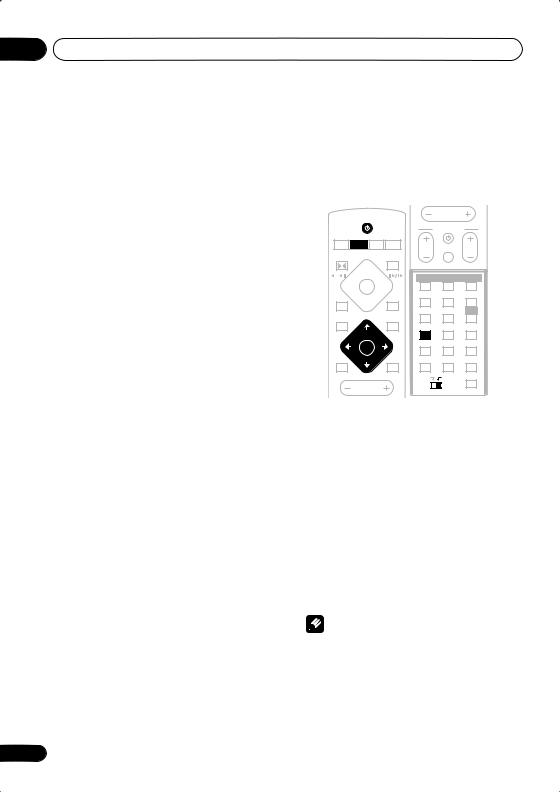
03 Getting started
•If you’re using the front panel controls, the TUNER button switches between FM, AM and station presets (see Memorizing stations below).
3 Tune to a frequency.
There are three tuning modes—manual, auto, and high-speed:
•Auto tuning: Press and hold TUNE +/– until the frequency display starts to move, then release. The tuner will stop on the next station it finds. Repeat to search for other stations.
•Manual tuning: Press TUNE +/– repeatedly to change the displayed frequency.
•High-speed tuning: Press and hold TUNE +/– until the frequency display starts to move rapidly. Keep the button held down until you reach the frequency you want. If necessary, fine tune the frequency using the manual tuning method.
Improving poor FM reception
If you’re listening to an FM station in stereo but the reception is weak, you can improve the sound quality by switching to mono.
1Tune to an FM radio station.
2Press SYSTEM SETUP.
3Use the /(cursor left/right) buttons to choose ‘FM Mode?’ then press ENTER.
4Use the / (cursor up/down) buttons to select ‘FM Mono’ then press ENTER.
The mono indicator ( ) lights when the tuner is in mono reception mode.
) lights when the tuner is in mono reception mode.
Select Auto above to switch back to auto-
stereo mode (the stereo indicator ( ) lights when receiving a stereo broadcast).
) lights when receiving a stereo broadcast).
Memorizing stations
You can save up to 30 station presets so that you always have easy access to your favorite stations without having to tune in manually each time.
|
|
|
|
|
MASTER |
|
|
|
STANDBY/ON |
|
VOLUME |
|
|
|
|
|
|
|
||
|
|
|
|
TV CONTROL |
||
CD |
FM/AM |
L1/L2 |
|
|
|
|
DVD |
TUNER TV |
LINE |
CH |
INPUT |
VOL |
|
|
|
|
|
|||
FRONT |
|
|
OPEN CLOSE |
|
|
|
SURROUND |
|
|
|
|
||
|
|
8 |
0 |
|
|
|
|
|
|
|
BASS MODE |
DIALOGUE |
CH LEVEL |
|
|
|
|
SURROUND |
ADVANCED |
VIRTUAL SB |
1 |
3 |
¡ |
|
|
|
|
|
|
|
|
PROGRAM |
REPEAT |
RANDOM |
4 |
|
|
4 |
AUDIO |
SUBTITLE |
ANGLE |
|
|
|
|
|
||
|
|
7 |
|
|
|
|
|
|
|
|
ZOOM |
TOP MENU |
HOME |
|
|
|
|
MENU |
||
DVD |
|
|
|
1 |
2 |
3 |
|
|
|
|
SYSTEM |
TEST TONE |
QUIET/ |
|
|
|
|
SETUP |
MIDNIGHT |
|
|
|
TUNE+ |
|
4 |
5 |
6 |
|
ST– |
ST+ |
DIMMER |
DISPLAY |
TIMER/ |
|
|
|
ENTER |
|
CLOCK |
||
|
|
|
7 |
8 |
9 |
|
|
|
|
|
|||
|
|
TUNE– |
|
SR+ |
FOLDER– |
FOLDER+ |
|
|
|
|
CLR |
0 |
ENTER |
|
|
|
|
MAIN |
SUB |
ROOM SETUP |
|
|
MASTER |
|
|
|
|
|
|
VOLUME |
|
|
|
|
1Tune to an AM or FM radio station.
For the FM band, select mono or auto-stereo reception as necessary. This setting is saved along with the preset.
2Press SYSTEM SETUP.
3Use the /(cursor left/right) buttons to choose ‘St. Memory?’ then press ENTER.
4Use the / (cursor up/down) buttons to select the station preset you want.
There are 30 preset locations; each can store one station preset.
5Press ENTER to save the station preset.
Note
•If the system is unplugged from the power supply completely, saved stations will remain for several days, after which you’ll
have to save them again.
22
En
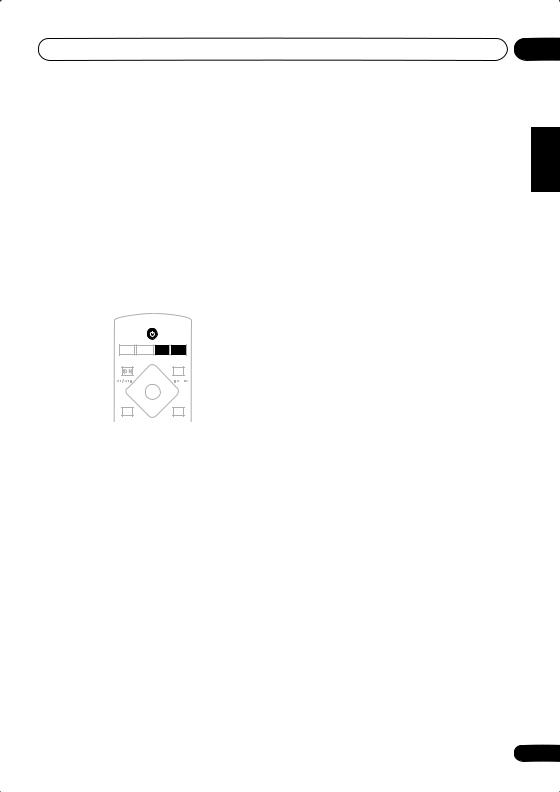
Getting started
Listening to station presets
1Make sure the TUNER function is selected.
2Use the ST +/– buttons to select a station preset.
Listening to other sources
You can connect up to three external sources (TV, satellite receiver, etc.) to this system, including one digital source. See also
Connecting auxiliary components on page 52.
|
STANDBY/ON |
|
CD |
FM/AM |
L1/L2 |
DVD |
TUNER TV |
LINE |
FRONT |
|
OPEN CLOSE |
SURROUND |
||
|
8 |
0 |
1 3 |
¡ |
|
4 |
|
4 |
|
7 |
|
1If the system isn’t already on, press STANDBY/ON to switch on.
Also make sure that the external source (TV, satellite receiver, etc.) is switched on.
2Select the source you want to listen to.
•If you’re using the remote control, press TV to select the TV IN input, or use the LINE (L1/L2) button to select the LINE 1 or LINE 2 input.
3If necessary, start playback of the
external source.
03
Español Nederlands Italiano Français Deutsch English
23
En
